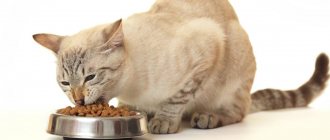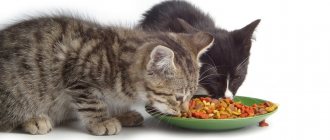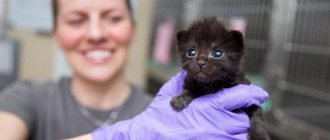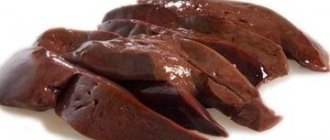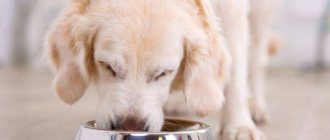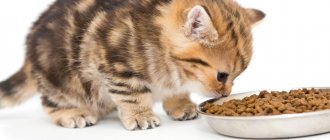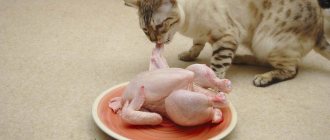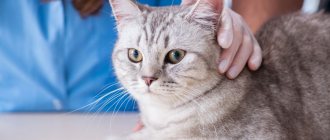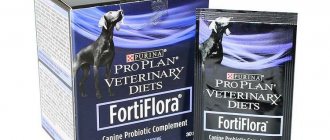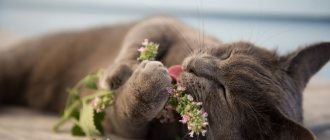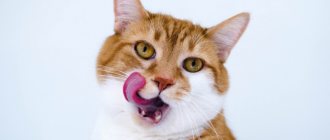We're guessing there are only two reasons why you came across this article. First, you catch your cat stealing a snack from the dog's bowl, and you can't help but wonder if you'll end up with a sick kitten on your hands later. Or secondly, you are completely out of cat food and wondering if cats can eat dog food.
Cats are certainly capable of eating dog food (as evidenced by my own moggy, who will happily try to dislocate his jaw to eat giant dog food!), but from a nutritional perspective, cats really shouldn't eat dog food .
Is dog food suitable for cats?
So, the short answer to the question of can cats eat dog food is: yes, but only in an emergency or for a short period of time. This is because cats and dogs have different dietary requirements. Dog food lacks the essential nutrition that cats need to live a long, healthy life. Cats are carnivores, which means they only eat meat. Dogs are omnivores, which means they eat meat, grains, and vegetables, so they need a more varied diet than just meat to meet their nutritional needs.
Before we get into the nitty-gritty details of why your cat can't eat dog food forever, it's important to start with the basics of cat nutrition and the difference between the nutritional needs of a cat and a dog.
© shutterstock
Everyone needs amino acids, but in different ways
At first glance, the most popular pets belong to the same order of predators, which means their diet should be similar. And this is true - cats and dogs are adapted to eating meat. However, these are still different species of animals that evolved under different conditions and have a different history of domestication.
Over the course of two dozen millennia of living next to humans, dogs have adapted to the absorption of some other sources of energy, in addition to animal protein and fat, although they remain a necessary basis of their diet. But cats were and remain obligate (Latin obligatus - obligatory, indispensable) predators, adapted to eat only meat.
This is the reason for the higher content of animal protein in cat food, which, in fact, makes it more expensive. These animals have a much higher need for amino acids, for example, an adult dog needs tryptophan 15 g per kg of body weight, a cat - 75 g, arginine, respectively - 70 g and 380 g, lysine - 60 g and 570 g.
Taurine is vital for cats
And so it is with almost all essential amino acids - cats should receive them from food in much larger (2-3 times) quantities. The content of taurine is especially significant for cats - an essential amino acid of exclusively animal origin; it is not found in any form in plant protein.
Dogs can synthesize taurine in the liver from methionine and cysteine, but in cats this ability is very limited, while this substance is involved in a huge number of processes occurring in the body, in particular, it is necessary for the normal functioning of the retina, heart, immune system, nervous, reproductive systems and platelet formation. If there is a lack of taurine, the cat will experience rapid development of cardiac pathology and retinal atrophy, and if measures are not taken, the death of the animal is inevitable.
Naturally, all these features are taken into account by manufacturers of dry food, increasing the content of animal protein in cat food and, as a last resort, adding taurine and other amino acids in synthesized form. In the Acana and Orijen diets, the high content of fresh meat serves this purpose.
What is cat food made of?
According to Dr. Sarah Ochoa, a small animal and exotic veterinarian in East Texas, cats absolutely need food containing taurine. Taurine is an amino acid that is important for normal heart function, vision and reproduction. Because taurine is found only in animal proteins, all cats require a meat-based diet to meet their nutritional needs.
Cat foods are very rich in protein, calories, fat and contain the required amount of taurine. Specifically, Patrick Mahaney, DVM, explains what a healthy cat food looks like:
- Natural whole food ingredients
- High quality animal proteins (at least 30%)
- Healthy animal fats (15% to 20%)
- Digestible carbohydrates and fiber
- Essential vitamins, minerals, enzymes and fatty acids
- No by-products, fillers or artificial additives
Feed differences
To find out why you can’t feed cats food for dogs, you need to understand the composition of the product and the characteristics of the effect of nutrients on the animal’s body.
Dry food
There are no significant differences in appearance. The composition is different.
- Dogs need less protein, so these substances are added to food in small quantities, while cats’ bodies cannot live without this component. They slowly digest plant and grain foods, and with an improper diet they suffer from digestive disorders and other diseases.
- Cat food contains a large amount of vitamin A, which is necessary to maintain vision and normal coat condition. In dog products, this component is not enough for the normal functioning of the cat’s body. As a result, the animal becomes weaker, hair falls out, and visual acuity is impaired.
- Taurine is an essential substance for the cat's body. It is simply not available in dog products. Found naturally in meat. Taurine is responsible for the complete digestion of fats, the stability of the nervous system, blood clotting, strong immunity, and excellent heart function.
When using dog food, cats develop problems with their well-being and health, their immunity decreases, and their appearance deteriorates.
Wet food
Canned or liquid food is not intended for regular consumption by animals. Not all important components are present in their composition. In this case, the feeds do not differ much, so they cause less harm if used “incorrectly.” Nothing terrible will happen, but the cat should not be allowed to eat canned dog food regularly.
For puppies
Food products for puppies are available in dry and wet forms. They differ from adult “treats” in the amount of nutritional components. In general, the composition does not change significantly. The recipe is developed taking into account age, breed, and species characteristics. If you give puppy food to cats constantly, the animals begin to undergo biological starvation, which leads to disruption of the functioning of the digestive organs, the development of serious diseases, and fatal pathologies. Puppy food is not suitable for cats.
Proplan for Yorkies
The food was developed by veterinarians and nutritionists of the famous ]Purina[/anchor]. Each recipe was created individually, taking into account the peculiarities of the functioning of the animal’s body. Separately, products are produced for dogs, cats, puppies, and kittens. Despite the fact that the food is of high quality, it is not recommended to use it for other purposes. The reason is all in the same nutritional components, which will not be enough to maintain the normal health of the pet. The cat eats the food with pleasure, it won’t do much harm, but you can’t feed it to it all the time.
Chappie
Well-known products for dogs are of high quality and affordable prices. When buying a large bag of food, the thought involuntarily creeps into your head as to whether you should give it to your cat. Before you do this, you need to remember the following:
- Chappie dog food does not contain taurine. Cats must receive it regularly, and it comes only from the outside; it is not produced by the body itself.
- The calorie content of cat products is much higher due to the presence of fats. Metabolic processes in cats occur faster; the main source of energy is not carbohydrates, but fats. Animals eat little by little, but often. Problems arise when there is a deficiency of fat in the diet.
- Cats require vitamin A, while Chappie dog products contain more zinc and vitamin E.
There is no point in experimenting, especially since the cost of the products is approximately the same. You should not give dry dog food to your cat, and you should also abandon the idea of feeding your pet canned food for other purposes.
What is the difference between dog and cat food?
Dog food contains protein, but also contains grains and vegetables necessary for their omnivory.
Cat food contains only proteins (no grains or vegetables) because they are carnivores.
Carbohydrates such as rice and corn in small quantities are good for cats but are not essential for a cat's diet. However, they usually play an important role in dog food.
© shutterstock
Why buy dog food?
The main reason is savings. Products for dogs are cheaper. They always buy large packages. To avoid additional expenses, cats are also given dog food. The second reason is simple ignorance. Many owners believe that all food is the same, only the name and purpose changes.
Actually this is not true. Anyone who carefully reads the information on the packaging will notice the differences. It is not for nothing that cat products are higher in calories, do not contain cereals or legumes, and vegetables are added in minimal quantities.
What should you do if your cat accidentally ate dog food?
If your cat accidentally eats your dog's lunch, don't worry.
Dog food is not harmful to cats, but it should not be regularly consumed in place of cat food. Cats can eat dog food without getting sick, even if it is not the best food for them.
Dr. Ochoa says if you find yourself in an emergency where you forgot to go to the store to buy more cat food and all you have is dog food, feed it to your cat. And if your cat takes a few pieces of food from your dog's bowl, there's nothing to worry about, she adds.
But cats cannot survive on dog food alone for their long-term diet. Without the right amount of protein, cats lose muscle mass and become lethargic. When it comes to taurine, VCA Animal Hospitals explains that the amino acid is critical for vision, digestion, heart function, fetal development and a healthy immune system in cats.
General information
In practice, if both a cat and a dog live in the house and are not fed in isolated areas, it is not uncommon for pets to calmly eat from each other’s bowls. Such cases are especially frequent if the food is of high quality and attracts both pets with its taste.
In such cases, the owner should be especially careful about the compatibility of dog food with the cat’s stomach.
Reasons why a cat doesn't eat as much from a dog's bowl:
- Current cat food is more sparse in content and the cat eats dog food because it suits her better.
- The cat is missing a specific ingredient in the dog's food.
- Dog food is fresher than what is currently offered to the cat.
How do I feed my multi-pet family?
Cats and dogs can live together in harmony, but their food dishes do not mix. The simplest solution for feeding cats and dogs: separate feeding areas.
Mikel Delgado, a cat behavior expert, suggests having separate food dishes for each animal in your home and placing them in different areas. "Keep in mind that cats will naturally prey on small animals that they don't share," she explains. “While it is a ritual for us to eat together, this is not the case with cats!”
Delgado also raises an excellent point about cats' natural instincts: "They prefer their own space and privacy when eating, and they don't always want to take turns eating at a communal bowl."
Posted by Becca Risa Luna is a writer and graphic designer. When she's not writing, you'll find her playing with her rescued mini schnauzer named Huxley and advocating for mental health.
How to prevent accidental eating of “not your own” food
What can you do to stop your dog from eating cat food and vice versa?
- It's quite simple:
- Do not leave food freely available.
- Feed your pets in different rooms.
- Place a barrier between bowls or remove them between feedings.
- Place your cat's bowl higher so your dog can't reach it.
- Install a cat door leading to the area where the cat eats. The size of the door should not allow the dog to get into the “cat’s canteen”.
- Feed the cat when the dog is walking.
Feed your pets a diet that is suitable for them. You can find out how to choose food from the many available on the market in our article: How to understand the variety of animal food?
__________
© All rights reserved. Partial or complete use of materials is permitted only subject to a link and/or a direct hyperlink open to search engines to the direct address of the material on the website Holistic-shop.ru
Which dry food to choose?
Depending on the composition and quality characteristics of the raw materials used for the production of finished feed, such diets are divided into three main classes:
- Economy feed is of very low quality. Such formulations are made from food waste and often contain low-quality or harmful components, including flavor enhancers and various preservatives. When using economy-class feed, the animal must be given additional vitamins and mineral complexes. The only advantages include affordable cost and long shelf life;
- standard-class or custom food containing all the components that are necessary for the normal, full functioning of a pet. However, such diets may contain a significant percentage of soy protein, which serves as a substitute for quality meat. Also, the composition can be supplemented with taste and smell enhancers, low-quality preservatives and dyes;
- Elite class food has very high quality characteristics and fully meets all the needs of your pet. The composition is represented exclusively by natural ingredients. Elite cat diets are enriched with vitamins and all minerals, as well as proteins of animal origin, which contributes to the complete and easy digestibility of the food. The meat part is 30% or more, and the amount of all plant ingredients is reduced to a minimum.
Among other things, all dry ready-made cat food is classified depending on the age characteristics of the pet:
- “for kittens” – with a high content of vitamins and minerals, which are very important for the fast-growing body of a pet;
- “for adult cats and kittens” – enriched with proteins that ensure the activity of the animal, with a minimum amount of ballast components;
- “for older cats and kittens” - with the optimal amount of vitamins, minerals, proteins and calcium to effectively strengthen the aging skeletal system.
It is very important when choosing food to pay special attention to the ingredients in the diet. High-quality feed is characterized by a minimal content of any by-products, which can be represented not only by the internal organs and skin of animals, but also by wool, hooves or horns
Conclusions and tips for feeding a cat
Is it possible to feed a dog dry and natural food at the same time?
The basis of healthy feeding is a balanced diet. If owners want to feed their domestic predator natural food, the best solution would be to contact a nutritionist. Only this specialist will be able to select a diet based on the individual needs of the cat, taking into account the animal’s weight, lifestyle and health status.
Only a specialist can choose a healthy diet for your cat.
Most owners feed their pet cats with ready-made food because it is more convenient and does not take much time. In addition, the food is as balanced as possible.
So why is a ready-made diet better than natural food:
- balance. There is no need to think about how much protein, fat and carbohydrates the animal will receive, and how to fit everything it needs into a small portion. The granules have already thought out the whole balance;
- saving time. The daily intake is already indicated on the packaging. No additional preparations, vitamins or supplements are required;
- compound. A conscientious manufacturer always writes the composition on the packaging, as well as the percentage of each element;
- big choice. Most foods have specialized and medicinal lines. And in case of allergies or intolerances, you can always replace one with the other. Fortunately, the choice is huge.
Feeds are divided into classes according to the quality of their composition:
- holistic;
- super premium;
- premium;
- economy
Important! There is no official gradation by class. The food may be declared by the manufacturer as super-premium, but in terms of composition it may turn out to be economy.
Some tips on how to choose the best food for your pet carnivore:
- You should choose premium and super-premium food. They have a perfectly balanced nutrient content for the cat's body;
- Veterinarians do not recommend feeding animals with economy class food. It has very low nutritional value and contains virtually no meat. It is replaced by offal of questionable quality;
- Feed manufacturers provide a huge range of flavors. The difference between one and the other is due to the different type of protein and fiber that the manufacturer uses. It is worth studying your pet's preferences. If you don't have allergies, any flavor will do;
- If, when changing food, the cat experiences lethargy, diarrhea or vomiting, it means that this particular food was not suitable for the pet. It is necessary to change the type, flavor or brand, and also visit a veterinarian;
- During the growth period, kittens require much more nutrients than in adulthood. Companies produce food created specifically for kittens. It has everything an actively growing body needs;
- You can combine dry and liquid food. The main thing is that both types are of the same brand.
Important! With prepared diets, it is very important not to feed food from the table. Such handouts upset the entire balance thought out by the producers of the ready-made diet. It can also negatively affect digestion.
Feeding pets in different rooms
Cats are animals that absolutely cannot go hungry. Hunger for more than 18 hours is dangerous for their body. If the animal is of normal weight, the bowl of food should be kept standing at all times. If a therapeutic diet or a diet for weight loss is prescribed, food should be given only for the duration of feeding (15-30 minutes).
If a cat, despite prohibitions, steals food from a dog, it means that it is necessary to feed the animals in different rooms or control the dog’s bowl until the dog eats his portion. The same should be done if there are several cats in the house who are prescribed different medicinal food. In this case, the food does not stand constantly, but is placed for 15-30 minutes. Then all food is removed until the next meal.
One serving at a time
There is always a table on the food package indicating how many grams of food a cat should eat per day. The portion depends on the animal’s weight, age and activity. This portion should be divided by the number of feedings and the calculated amount of grams should be poured into a bowl. You can buy a measuring cup at a pet store. It is convenient for them to measure portions for feeding. Do not be afraid that the portion is too small, since food swells in the stomach, and there are always enough nutrients for the normal functioning of the body.
Feed calculation table
It is important to consider the stage of life
There is an organization called the American Association of Feed Control Officials (AAFCO) that closely monitors the pet food industry.
Pet foods that meet AAFCO standards have a label that says “formulated by AAFCO for... (life stage).”
There are three main stages:
- Height
- Care
- All stages of life
Cats' protein, vitamin and nutrient requirements change throughout their lives.
Kittens, which are growing quickly, need more nutrients, and older animals need more protein to maintain muscle strength.
Dog foods that are lower in protein and nutrients are not able to sustain cats over the long term.
Taurine and arginine
These are essential amino acids for the cat’s body; if they are deficient, serious and dangerous conditions develop not only for the health, but also for the life of the pet. Taurine is contained in large quantities in the retina of a cat’s eye, and therefore, with its chronic deficiency, vision primarily suffers, and over time the animal inevitably goes blind. In addition, taurine is extremely important for the cardiovascular and nervous systems, blood clotting, reproductive and gastrointestinal function, and much more.
Arginine is no less important; if it is deficient, ammonia accumulates in the blood, which can have fatal consequences.
Packed rations or canned food?
There is still fierce debate on this topic among animal lovers, with no end in sight. However, there is no clear answer to this question.
Dry food
Oddly enough, dry food is not the worst option. In any case, it is definitely no worse and much safer than food waste, which is full of spices and salt, which do not have the best effect on the baby’s health
It is only important to understand that the animal’s daily diet should consist of at least 70% wet food. This requirement applies to kittens under six months of age.
From six months of age to one year, the ratio is adjusted to 50/50. If you buy good food, then there is nothing wrong with using it.
Wet food
Again, contrary to the common misconception that wet food is the best option for feeding kittens, in practice everything is not so clear-cut. It is better only if the product belongs to the “Premium” or “Super-premium” class. Cheap wet food is frankly dangerous for the health of kittens, since there is simply nothing useful in it. At best, it is a mixture of ground sinews and hooves with gelatin and cereals.
It would seem a banal rule, but owners often forget about it. Simply put, the kitten will be much healthier if you give it a good dry diet, rather than cheap canned food that does not and never has had meat.
Oh is also not a panacea. If a kitten is underfed or, on the contrary, overfed, nothing worthwhile will grow out of it. In order for the pet to be truly healthy and vigorous, in any case it would not hurt the owner to consult a veterinarian.
